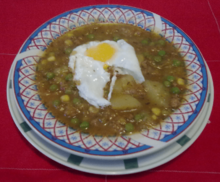Charquicán facts for kids

Charquicán
|
|
| Type | Dry meat |
|---|---|
| Course | Main |
| Place of origin | Argentina, Chile, Bolivia, Peru |
| Region or state | Andean |
| Created by | Aymara |
| Serving temperature | Hot |
| Main ingredients | ch'arki (jerky),l |
| Variations | Valdiviano, Tomatican. Modern versions use minced meat instead of jerky. |
Energy: 391 Kcal
|
|
Charquicán is a popular and hearty stew from South America. It's especially well-known in countries like Chile, Argentina, Bolivia, and Peru. This dish has been enjoyed for a very long time, even since the days of the Incas.
The name "Charquicán" comes from the word ch'arki, which means "jerky" or dried meat. This shows that dried meat was a main ingredient in the original recipe. Today, Charquicán is a comforting meal often made with fresh meat and vegetables.
In Chile, Charquicán is a thick stew. It usually has beef or charqui (dried meat). Other key ingredients are potatoes, pumpkin, white corn, and onion. Sometimes, peas and more corn are added too. The very first versions used dried llama meat or beef. Modern Chilean Charquicán often uses minced beef and is served with a fried egg on top.
In Peru, Charquicán is sometimes made with dried fish, like Guitarra fish. People often eat this fish version during Easter. This fish stew includes diced potatoes and is served with white rice. Sometimes, chickpeas are also part of the meal.
Contents
What is Charquicán?
Charquicán is a type of stew that has been eaten for centuries. It's a great example of how people used to preserve food. Drying meat, like making jerky, was a common way to keep it from spoiling. This allowed people to carry food on long journeys.
The Meaning Behind the Name
The word "charquicán" likely comes from "charquikanka". This is a Quechua word. Quechua is a language spoken by many people in the Andes mountains. It means "stew with ch'arki".
Another idea is that the name mixes two languages. It could be from the Quechua word ch'arki and the Mapudungun word cancan. Mapudungun is the language of the Mapuche people. Cancan means "dried roasted meat".
Charquicán's Journey Through History
This stew was a common meal for travelers. Merchants often ate it when moving between the port of Arica and the mines of Potosí. Farmers also ate it while guiding their animals.
Later, during the Chilean War of Independence, soldiers enjoyed a version called Charquicán cuyano. It was a good, filling meal for them.
Different Kinds of Charquicán
Over time, people have created different versions of Charquicán. These variations often use local ingredients or add new flavors.
- Tomatican: This version is made with added tomatoes. The tomatoes give it a fresh, tangy taste.
- Charquicán of quchayuyu: Also called Cochayuyicán, this is a unique variation. Instead of meat or jerky, it uses quchayuyu seaweed. This seaweed is also known as Durvillaea antarctica. It's a healthy and interesting twist on the classic stew.
See also
 In Spanish: Charquicán para niños
In Spanish: Charquicán para niños

